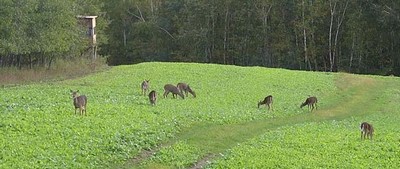Much of the work regarding the use and necessity of food plots for white-tailed deer comes from the southeastern part of the whitetail’s range. Soil fertility and water abundance in the southeast are relatively poor compared to the North and mid-West. Soil fertility is an indicator of food quality and quantity, and we all know that good soils result in good food plots. That being said, food plots for whitetail deer in Michigan are a good idea for any hunter or landowner interested in a plot for hunting or providing supplemental nutrition.
Food supplementation through food plots can be important for managing deer just about anywhere, but whitetail populations are not as dependent upon supplemental plots in the mid-west going northward. They, of course, will use food plots if they are available. The productive soils found in the region support a plethora of foods for white-tailed deer and other wildlife where areas exists with a mixture of agricultural crops, woodlots, and old fields. But there are many areas of Michigan and surrounding states that lack foods for deer.

For hunters interested in providing deer, especially bucks, optimal nutrition, then food plots are the way to go. One of the best plots that I’ve heard of is a food plot seed mix that has four different plant species. It includes a mixture of annual rye, oats, and clover with a chicory kicker. This simple plot mix has worked well in Michigan and has been our most successful combination up north. It works year-round because each of the seeds provides a specifically targeted goal and, most importantly, grows as a very beneficial winter food plot for hunting.
We’ve played with the mix a bit, but the ratio that works best for deer in our food plots is a mix of 50 pounds of oats, 50 of annual rye, and 8 pounds of clover, and 1 pound of chicory. This is per acre. It’s a fairly heavy seeding rate, but it also helps keep competing weeds out. The mix is highly adaptable and it works through the year. Annual rye is one of the most tolerant seed types. It can grow under a variety of conditions and it will stay alive throughout the winter. Oats are a solid deer food during the hunting season, but will freeze out as temperatures drops. This is the idea.
When spring arrives, the clover will take off and deer will shift over. The rye will hang on for a while, but because the oats have died they will not compete and allow the establishment of the clover in the spring. That little bit of extra light hitting the ground is all that it needs.
This seed mix consisting of oats, rye, clover and chicory should be seeded to a firm bed in late summer.
An effective spring and summer food plot for Michigan hunters is to plant the bulk of your are with soybeans, but leave about a 20 yard strip all way around the outer perimeter of the plot. Then, in early September, seed the outer strip around the beans with oats for your winter food plot. The highly quality oats will come up fast and attract deer during the archery and gun seasons. Soybeans are a great high protein food source for Michigan deer from November to January. A combination of plants is the key to a successful food plot.
There are additional options for those looking to plant food plots for whitetail deer in Michigan, but be prepared to pay substantially more if you turn to commercial food plot mixes. The best food plot is the one that will grow and provide food and attract deer during the hunting season. There is now secret to a good plot, they just require some planting and a little work. Learn how to plant food plots for deer before you buy seed and waste both time and money.
Where do you buy this plot food?